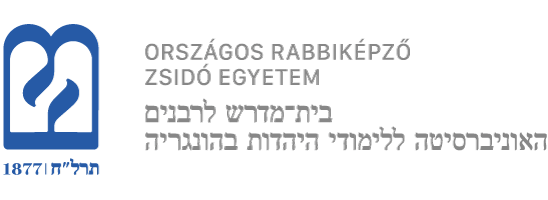The Jewish Theological Seminary of Budapest (Országos Rabbiképző Intézet, or Landesrabbinerschule) was opened in 1877 as the rabbinical seminary of the neolog movement, the Hungarian branch of positive-historical Judaism. The centre of the Wissenschaft des Judentums in Hungary, “a middle-of-the-road college on the Breslau model” [1], its aim was to train rabbis who were well-versed in the Bible, rabbinic texts, Hungarian culture and contemporary science, and who would be able to serve the then-flourishing, Hungarian speaking, modernizing Jewish communities.

The middle of the nineteenth century in Hungary witnessed a bitter struggle between a strictly orthodox camp, the heirs of Moses Schreiber (known as the Hatam Sofer), on the one hand, and communities that were open to modernity and certain innovations, on the other. Magyarization and embourgeoisement affected all Hungarian Jewry, yet at very different paces. Neolog Judaism ranged from moderate reform (such as the Dohány Street Synagogue in Pest, or the Szeged community headed by rabbi Leopold Löw) to truly traditionalist communities. The schism between orthodoxy and neolog Judaism was institutionalized in the aftermath of the 1868-69 Hungarian Jewish congress.
It was this congress that resolved, following the secession of the orthodox representatives, “to establish the Seminary, emphasizing that the teaching of the Talmud and Codes would be an important part of the curriculum, which, at the same time, would take into consideration the cultural and scientific gains of the nineteenth century” [2]. Hence, the Seminary was to combine traditional rabbinic training with the spirit of the Wissenschaft (Jewish studies as a scientific field), in accordance with Zecharias Frankel’s Positive-Historical School. Its financial basis was the Jewish Education Fund, which had been created in 1850 by Emperor Francis Joseph I, from the fine imposed on Jews for their participation in the 1848–49 Hungarian revolution.
The new institution opened its doors on October 4, 1877. Its first director was Moses Löb Bloch (1815–1909), a respected rabbinic authority and Talmudic scholar, whose compelling Jewish and secular knowledge should have simultaneously pleased the orthodox and the modern camps. He was assisted by two, then young professors, both educated and ordained at the Jewish Theological Seminary of Breslau. David Kaufmann (1852–1899), a scholar of unusually wide and thorough knowledge, best known for his work on medieval Jewish philosophy and his collection nowadays at the Library of the Hungarian Academy of Sciences, and also founder of our university library, was professor of Jewish history, philosophy and homiletics. Wilhelm Bacher (1850–1913), a prolific scholar of biblical exegesis, Hebrew philology, Aggadah and Midrash, and Judeo-Persian literature, would become the second head of the seminary in 1907. Following the untimely passing of Kaufmann, Ignaz Goldziher (1850–1921), a world leading scholar of Islam, was also invited to take over courses on philosophy and the history of religions.
Up until the mid-twentieth century, the Seminary consisted of two, five-year-long programmes. The “lower programme” was comparable to a standard high school, offering strong secular (European) and Jewish basic education, concurrently. Following the graduation exam, future rabbis entered the “higher programme”, covering not only Biblical and Talmudic studies, homiletics and halakha, but also history, philosophy and oriental languages. Many students spent a semester or year studying at the Breslau or Berlin seminaries. Parallel to their rabbinic training, they also attended courses at the University of Budapest, where they had to obtain a doctoral degree before being ordained. This is how they would become well-respected spiritual and intellectual leaders of their modernizing communities.
After Bacher’s death, the institution was taken over by a new generation of former graduates of the Seminary. The third director, Ludwig Blau (1861–1936), a world-class scholar of Jewish studies, was followed by Talmudic scholar Michael Guttmann (1872–1942) between 1933 and 1942; and by Samuel Löwinger (1904–1980) from 1943 to 1950. This period came to a sudden end in 1944. Numerous scholars and students perished in the Holocaust, the building of the seminary was confiscated by the SS, and parts of the library were looted.

In the subsequent years, many Jews left the country, including Löwinger, who migrated to Israel in 1950. Alexander Scheiber (1913–1985) first headed the institution together with Ernst Roth (1908–1991). When the latter left Hungary in 1956, Scheiber was the one to keep the flame of Jewish scholarship alive under the communist regime. As the sole rabbinical school in the Soviet Bloc, the Seminary trained rabbis and cantors from Sophia to Moscow, while émigrés were hired by congregations from Vienna to Berkeley, California and Indianapolis. An extremely fruitful scholar, Scheiber contributed to the fields of Hungarian Jewish history, folklore, art and literature, as well as Genizah studies. The next director, Joseph Schweitzer (1922–2015) followed Scheiber’s path in many ways, and he paved the road to a new era between 1985 and 1998, with new opportunities opening up after 1989.
In the 1990s, the Seminary gradually broadened its profile, including a teacher training program and social work. Under the leadership of Alfréd Schőner (1948–), it became a state-recognized university in 2000, and was renamed Jewish Theological Seminary – University of Jewish Studies (OR-ZSE) [3]. New academic programmes were launched, and a doctoral school was founded. As of 2018, the rector of the university is Karl Vajda (1969–), a scholar of German and comparative literature, whose goal is to save the Seminary’s old values while building a truly twenty-first century university.

